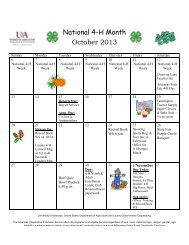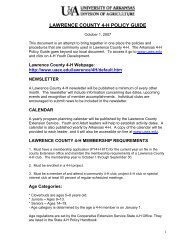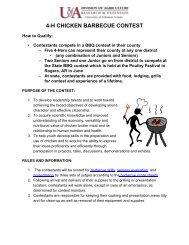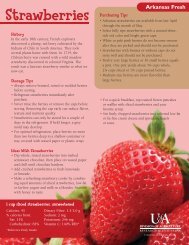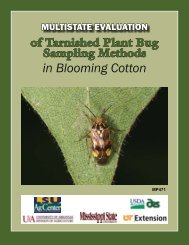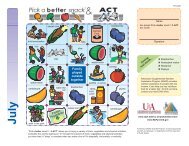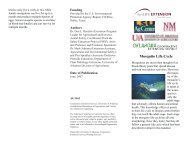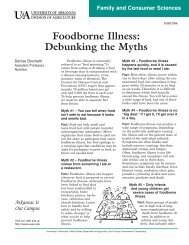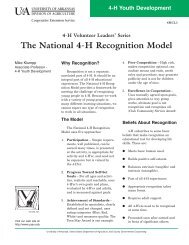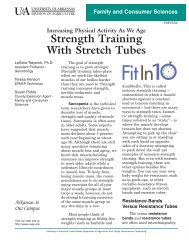Evergreen Hedge Or Screen Plants - University of Arkansas ...
Evergreen Hedge Or Screen Plants - University of Arkansas ...
Evergreen Hedge Or Screen Plants - University of Arkansas ...
Create successful ePaper yourself
Turn your PDF publications into a flip-book with our unique Google optimized e-Paper software.
<strong>Hedge</strong> or <strong>Screen</strong> <strong>Plants</strong><br />
for <strong>Arkansas</strong><br />
Historically, the two most common landscape<br />
plants used for hedge or screen purposes in<br />
<strong>Arkansas</strong> would be redtip photinia (Photinia<br />
xfraseri) or Leyland cypress (ΧCupressocyparis<br />
leylandii). While both <strong>of</strong> these plants are superb<br />
hedge or screen plants, both candidates are in<br />
decline due to disease problems. In the case <strong>of</strong><br />
redtip, the fungal problem is Entomosporium leaf<br />
spot (FSA6112, Leaf Spot <strong>of</strong> Redtip Photinia, at<br />
www.uaex.edu). In some cases, this disease can<br />
be so serious in <strong>Arkansas</strong> that a hedge will be<br />
leafless in June. Gardeners in states west and<br />
south <strong>of</strong> <strong>Arkansas</strong> <strong>of</strong>ten have less <strong>of</strong> a problem<br />
with this serious disease. The ever‐popular<br />
Leyland cypress has its own fungal problems<br />
(Seiridium and Botryosphaeria cankers) that<br />
make its future equally perilous (FSA7536,<br />
Branch Canker and Dieback <strong>of</strong> Leyland Cypress, at<br />
www.uaex.edu).<br />
Suggesting alternatives is no short order, and it<br />
would be misleading to assume that cookie‐cutter<br />
options lie in wait. However, there are a number <strong>of</strong><br />
plants that fit the mold fairly well (see the table).<br />
Alternative <strong>Hedge</strong>/<strong>Screen</strong> Options for <br />
Redtip Photinia and Leyland Cypress<br />
Genus<br />
Broadleaf <strong>Evergreen</strong>s<br />
Common Name<br />
USDA Cold<br />
Hardiness<br />
Zone z<br />
Growth Rate<br />
Height ×<br />
Width<br />
Elaeagnus xebbingei Elaeagnus 6-9 Very fast 15' × 15'<br />
Ilex cornuta<br />
‘Burfordii’<br />
Ilex crenata<br />
‘Sky Pencil’ or ‘Steeds’<br />
Burford Chinese Holly 6-9 Fast 18' × 15'<br />
Japanese Holly 6-8 Medium 8' × 15'<br />
Ilex opaca American Holly 5-9 Medium 35' × 15'<br />
Ilex xattenuata<br />
‘Fosteri’<br />
Foster Holly<br />
6-9 Medium<br />
25' × 10'<br />
Ilex x‘Emily Bruner’ Emily Bruner Holly 7-9 Fast 18' × 10'<br />
Ilex xkoehneana Koehne Holly (6b)7-9 Medium 20' × 12'<br />
Ilex x‘Nellie R. Stevens’ Nellie Stevens Holly 6-9 Fast 18' × 12'<br />
Ilex xOakland Holly 6-9 Medium 14' × 8'<br />
Illicium parviflorum Small Flowered Anise-tree 7-9 Medium 10' × 7'<br />
Ligustrum japonicum<br />
Japanese Privet<br />
Waxleaf Privet<br />
7-9 Medium-fast 12' × 12'<br />
Loropetalum chinense var. rubrum Chinese Fringeflower 7-9 Fast 10' × 10'<br />
Magnolia grandiflora Southern Magnolia 6-10 Medium-fast 30' × 10'<br />
z Cold hardiness zone 6b equates to Fayetteville, zone 7 to Little Rock and zone 8 to Hope, <strong>Arkansas</strong>.<br />
5




